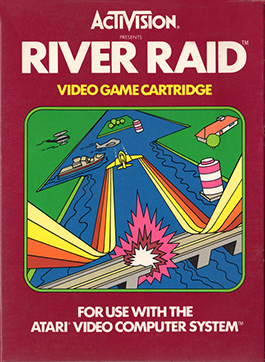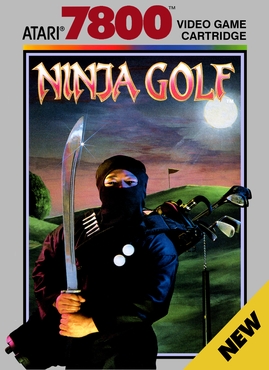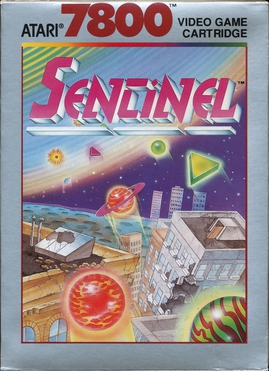
The Atari 2600 is a home video game console developed and produced by Atari, Inc. Released in September 1977 as the Atari Video Computer System, it popularized microprocessor-based hardware and games stored on swappable ROM cartridges, a format first used with the Fairchild Channel F in 1976. The VCS was bundled with two joystick controllers, a conjoined pair of paddle controllers, and a game cartridge—initially Combat and later Pac-Man. Sears sold the system as the Tele-Games Video Arcade. Atari rebranded the VCS as the Atari 2600 in November 1982 alongside the release of the Atari 5200.

The Atari 7800 ProSystem, or simply the Atari 7800, is a home video game console officially released by Atari Corporation in 1986 as the successor to both the Atari 2600 and Atari 5200. It can run almost all Atari 2600 cartridges, making it one of the first consoles with backward compatibility. It shipped with a different model of joystick from the 2600-standard CX40 and Pole Position II as the pack-in game. Most of the announced titles at launch were ports of 1981–1983 arcade video games.

Kaboom! is an action video game published in 1981 by Activision for the Atari 2600. The gameplay was based on the Atari arcade game Avalanche (1978), with the game now involving a Mad Bomber who drops bombs instead of falling rocks. Kaboom! was programmed by Larry Kaplan with David Crane coding the graphics for the buckets and Mad Bomber. It was the last game designed by Kaplan for Activision, who left the company shortly after the release of the game. The game was later ported by Paul Wilson for the Atari 5200 system.

Missile Command is a 1980 shoot 'em up arcade video game developed and published by Atari, Inc. and licensed to Sega for Japanese and European releases. It was designed by Dave Theurer, who also designed Atari's vector graphics game Tempest from the same year. The game was released during the Cold War, and the player uses a trackball to defend six cities from intercontinental ballistic missiles by launching anti-ballistic missiles from three bases.

The Atari XE Video Game System is an industrial redesign of the Atari 65XE home computer and the final model in the Atari 8-bit family. It was released by Atari Corporation in 1987 and marketed as a home video game console alongside the Nintendo Entertainment System, Sega's Master System, and Atari's own Atari 7800. The XEGS is compatible with existing Atari 8-bit family hardware and software. Without keyboard, the system operates as a stand-alone game console. With the keyboard, it boots identically to the Atari XE computers. Atari packaged the XEGS as a basic set consisting of only the console and joystick, and as a deluxe set consisting of the console, keyboard, CX40 joystick, and XG-1 light gun.

Solaris is a space combat video game for the Atari 2600 published in 1986 by Atari. The game involves a player seeking out the planet Solaris via their starship. To accomplish this, the player must navigate the galactic scanner to explore quadrants of a map. Doing so allows them to explore Federation planets to refuel their ship, and engage in combat with hostile aliens known as the Zylons.

Klax is a puzzle video game released in arcades in 1990 by Atari Games while Namco distributed the game in Japanese markets. It was designed and animated by Mark Stephen Pierce with the software engineering done by Dave Akers. The object is to catch colored blocks tumbling down a machine and arrange them in colored rows and patterns to make them disappear. Klax was originally published as a coin-op follow-up to Tetris, about which Atari Games was in a legal dispute at the time.

Jr. Pac-Man is an arcade video game developed by General Computer Corporation and released by Bally Midway on August 13, 1983. It has the same gameplay as prior entries in the series, but the maze in Jr. Pac-Man scrolls horizontally and has no escape tunnels. The bonus item which moves around the maze changes dots into a form which slows Jr. Pac-Man as they are being eaten.

Kung-Fu Master, known as Spartan X in Japan, is a side-scrolling beat 'em up developed by Irem as an arcade video game in 1984, and distributed by Data East in North America. Designed by Takashi Nishiyama, the game was based on Hong Kong martial arts films. It is a loose adaptation of the Jackie Chan, Sammo Hung, and Yuen Biao film Wheels on Meals (1984), called Spartan X in Japan, with the protagonist Thomas named after Jackie Chan's character in the film. The game is also heavily inspired by the Bruce Lee film Game of Death (1972), which was the basis for the game's concept. Nishiyama, who had previously designed the side-scrolling shooter Moon Patrol (1982), combined fighting elements with a shoot 'em up gameplay rhythm. Irem and Data East exported the game to the West without the Spartan X license.

Summer Games is a sports video game developed and published by Epyx based on sports from the Summer Olympic Games. Released in 1984 for the Commodore 64, it was ported to the Apple II, Atari 2600, Atari 7800, Atari 8-bit family, and Master System.

River Raid is a video game developed by Carol Shaw for the Atari Video Computer System and released in 1982 by Activision. The player controls a fighter jet over the River of No Return in a raid behind enemy lines. The goal is to navigate the flight by destroying enemy tankers, helicopters, fuel depots and bridges without running out of fuel or crashing.

The Atari Flashback series are a line of dedicated video game consoles designed, produced, published and marketed by AtGames under license from Atari SA. The Flashback consoles are "plug-and-play" versions of the Atari 2600 console. They contain built-in games rather than using the ROM cartridges utilized by the 2600. Most of the games are classics that were previously released for the 2600, although some Flashback consoles include previously unreleased prototype games as well.

The Atari XG-1 light gun is a video game controller which was released in 1987. As Atari's only light gun, it is unique to the 8-bit family. It is compatible with the Atari XEGS, and with the 7800 and 2600 home video game consoles. It was bundled with the XEGS Deluxe home computer and video game console combination system, and with the light gun game Bug Hunt for the 7800 as model XES2001 for US$34.95. Atari eventually released five light gun games on the 7800 and one on the 2600 (Sentinel).

Megamania is a video game developed by Steve Cartwright and published by Activision in 1982. The game is a fixed shooter, where a pilot of an intergalactic space cruiser who after eating a variety of food, has a nightmare where his ship is being attacked by food and house hold objects. Using the missile launcher from his space cruiser, he finds himself being attacked by various food items and house hold objects.

Ninja Golf is a beat 'em up/golf video game developed by BlueSky Software and published by Atari Corporation for the Atari 7800. Gameplay consists of the ninja player character hitting a golf ball at the beginning of each hole (stage) then fighting various enemies in side-scrolling sections to reach it. Each green is guarded by a fire-breathing dragon boss that the player must defeat by throwing shurikens.

Tutankham is a 1982 arcade video game developed and released by Konami and released by Stern in North America. Named after the Egyptian pharaoh Tutankhamun, the game combines a maze shoot 'em up with light puzzle-solving elements. It debuted at the European ATE and IMA amusement shows in January 1982, before releasing worldwide in Summer 1982. The game was a critical and commercial success and was ported to home systems by Parker Brothers.

The first hobbyist-developed game for the Atari 2600 video game console was written in 1995, and more than 100 have been released since then. The majority of games are unlicensed clones of games for other platforms, and there are some also original games and ROM hacks. With only 128 bytes of RAM, no frame buffer, and the code and visuals closely intertwined, the 2600 is a difficult machine to program. and many games were written for the technical challenge. Emulators, programming tools, and documentation are available.

RealSports Baseball is a 1982 sports video game developed and published by Atari, Inc. originally for the Atari 2600. It was also launched on the Atari 5200 and 7800 machines. A version for the Atari 8-bit family of home computers was also in development, but it was cancelled.

Sentinel is a 1990 video game developed by Imagineering and published by Atari for the Atari 2600. It is the only light gun game ever released for the Atari 2600 platform. It was re-released with improved graphics for the Atari 7800 in 1991.
RealSports is a series of sports video games originally developed and published Atari, Inc. The first games were released in 1982 for the Atari 2600, then the series expanded to the Atari 5200, Atari 7800, and Atari 8-bit family. By the early 1980s, Atari's initial sports releases for the VCS—Home Run and Football—were dated in terms of visuals and gameplay, and targeted by an Intellivision ad campaign from Mattel. The RealSports series was an attempt by Atari to revitalize the sports game lineup for their consoles.



















